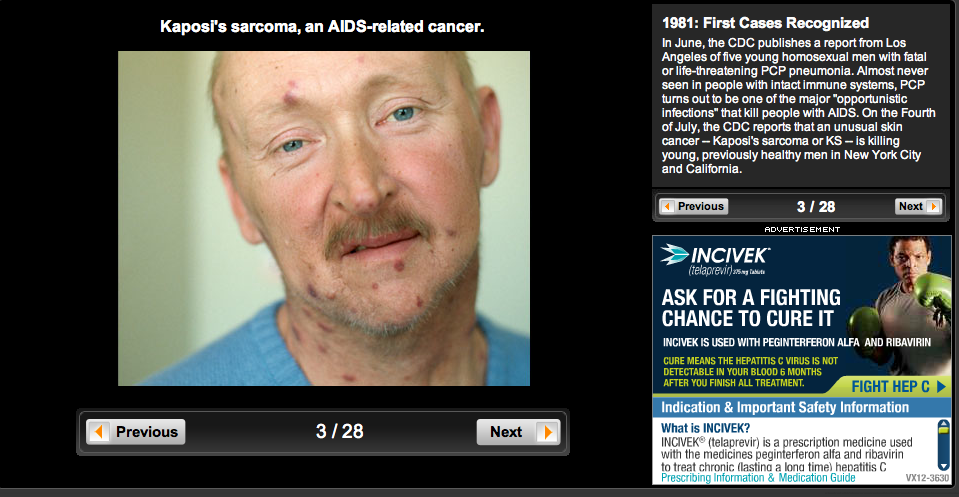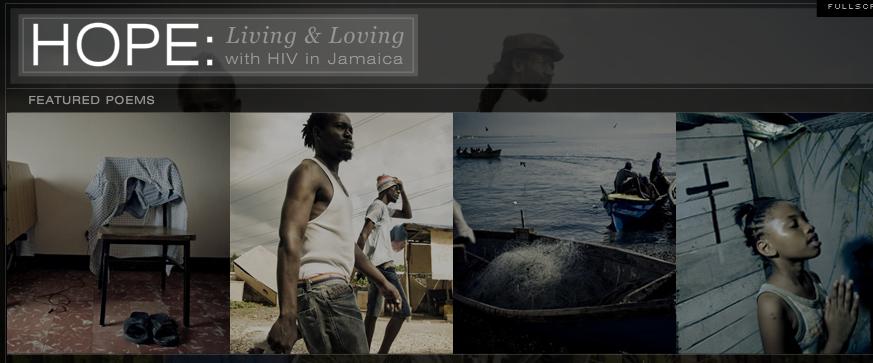Transmission: Considering New Media and the Online Histories of HIV/AIDS
By Christopher Garland
University of Florida
2011 marked the thirtieth anniversary of the emergence and subsequent global recognition of the HIV/AIDS pandemic. This column considers the historicization of HIV/AIDS, particularly in the context of the new media. Taking a lead from Dipesh Chakrabatvy’s claim that “we can think only out of the experiences and discussions of our own times, about which we can never be as fully informed as future historians might be,” I address the historicization of HIV/AIDS online, and explore some of the ways that new media responds to the urgent need to comprehend as much about the pandemic—and therefore its history—as possible.1 To put past events into a comprehensible narrative is the challenge for all historians, but, in the case of the HIV/AIDS phenomenon, this problem becomes increasingly acute. HIV/AIDS is, after all, an ongoing crisis for humanity.
While the rate of new HIV infections has decreased by 19 percent since 1999, which was considered the high-water mark of the epidemic globally, according to the 2010 UNAIDS Global Report, an estimated 33.3 million people living with HIV/AIDS in countries worldwide today. Over 22 million of infected adults and children reside in sub-Saharan Africa,2 but the nations with the biggest epidemics in this region—Ethiopia, Nigeria, South Africa, Zambia, and Zimbabwe—have stabilized or reduced rates of infection.3 However, in five countries in Eastern Europe and Asia, including Ukraine—where diagnoses have doubled since 2001 and encompass over 1.1 percent of the total population—the Russian Federation, the Phillipines, and Pakistan, the rate of infection has grown.4 The most startling statistic is more holistic: the total number of people with HIV/AIDS in Central Asia and Eastern Europe has almost tripled since 2000.5
Thus, in the face of a pandemic whose history consists of the death of over 30 million humans around the globe, how does one make HIV/AIDS history? Due to its almost universal reach, is the history of HIV/AIDS by necessity a global history? And is it possible to historicize the global reach of HIV/AIDS? Or should the history of HIV/AIDS always be told in relation to specific national and/or cultural contexts? Moreover, how does a historical narrative grapple with the myriad discourses—from medical science to sociological and anthropological study—that constitute the body of knowledge concerning the HIV/AIDS pandemic? One could also consider how theoretical models are used to interrogate specific historical events—trauma or Marxist theory, for example—while thinking the utility of applying these models to historicizing HIV/AIDS. New media has changed the way that histories are constructed, and the aforementioned questions about HIV/AIDS history must be posed in terms of the potential of Internet and the devices (cellphones, laptops) that allow the sharing of information about the epidemic.
Notably, the origins of this new media and HIV/AIDS share a “lifespan;” the emergence of HIV/AIDS occurred at the same time as the spread of the foundational device, the personal digital computer. August 1982 marks both the release of the Commodore 64 and the first national AIDS forum in the United States. The transition from print to digital culture not only altered how histories of the HIV/AIDS are constructed, but also the objects of primary historical research. For example, one can trace the medium of HIV/AIDS transmission information from pamphlets distributed hand to hand during the first years of the American epidemic to NGO-sponsored web portals that contain both testing and treatment advice. Three examples that show different approaches to historicizing HIV/AIDS through new media—whilst also tending to the necessity of health information—include WebMD.com’s “AIDS Retrospective Slideshow: A Pictorial Timeline of the HIV/AIDS Pandemic,”6 the National Institute of Health’s “In Their Own Words,”7 and the integration of HIV/AIDS activism, education, and history available on the website of AVERT, an international charity based out of the United Kingdom.8
Of all the histories of HIV/AIDS available on the Internet, I have selected these three because they demonstrate different form, function, and attention to potential Internet audiences. The WebMD image-based history is notable not because of its depth or breadth—it utilizes a single image next to a pithy description—but because it demonstrates that even though a website is not bound to the same physical restrictions of a printed text, the basic question of historiography is brought to the forefront: what and why are particular events included, and what and why are other events excluded or omitted?

The WebMD timeline begins with an image of the AIDS memorial quilt as displayed at Washington DC’s National Mall in 1987; the accompanying caption notes that AIDS-related illnesses have accounted for “half as many deaths as in World War II” and that “it’s not over.” The last sentence in the caption is the focal historical question: “How did we get here?” Clicking on the arrow for the next slide leads to a close-up image of a chimpanzee, and the accompanying text describes the “spillover” moment, when a hunter in West Central Africa was infected: probably through an open wound inflicted either during or before the butchering of an HIV-carrying chimp for human consumption.
The connection between the origin of human infection in the early 1900s and the critical point of the epidemic in the late 1980s is followed in the third slide image with the human face of infection: it is a close-up of a middle-age man whose skin is marked by Kaposi’s sarcoma lesions, one of the “opportunistic diseases” that prey on immune systems weakened by HIV.

This snapshot history, where the HIV/AIDS pandemic is chronicled through 28 powerful images and succinct descriptions, is in stark contrast to the NIH’s “In Their Own Words” project, which is an incredibly detailed history from the viewpoint of health care providers. For example, the images available to view on the website range from a map that shows the countries first affected by the pandemic to flow charts and schematics regarding treatment via antiretroviral drugs. While “In Their Own Words” has a particular emphasis on the experience of health practitioners in the first two decades of HIV/AIDS, AVERT’s AIDS history provides not only a year by year account of the pandemic, but also works as a dynamic synthesis of accounting for the past while facing this ongoing crisis: with one click one can move from a description of Manhattan’s first official needle exchange program, to an embedded video targeting teenagers about contraception and prevention. This is where new media shows just how powerful it can be in both telling the history of HIV/AIDS and addressing it as a contemporary crisis: a necessary function because, as is made abundantly clear by the continued high rate of new infection around the world, the history of HIV/AIDS is, to paraphrase William Faulkner’s famous adage, neither dead nor past.

New media also enables the delivery of information about histories that are, for the most part, not (yet) available online. One example of this is the University of California, San Francisco’s AIDS History Project. As one of the cities hit hardest by the American AIDS epidemic, the medical, sociological, and historical texts related to HIV/AIDS available at UCSF are both diverse and extensive. The project began in 1987, coinciding with the aforementioned AIDS memorial quilt venture (which also originated in San Francisco), and UCSF’s library website provides a portal for information about this wide-ranging archive.9
The intersection of new media and HIV/AIDS history is also visible in the art, available online, that has been produced as a response to the crisis. What follows are just a few examples of AIDS art from around the world: the virtual collections of HIV/AIDS art available through Artery: the AIDS-art forum,10 Kwame Dawes’ “HOPE: Living & Loving with HIV in Jamaica,”11 and the numerous projects viewable at South Africa’s artaidsart.12

While scholars working within the realm of cultural studies have looked at the historical context of various texts responding to HIV/AIDS—through critical analysis of AIDS information posters in San Francisco and New York in the 1980s and film and theatre including Philadelphia, Angels in America, and Rent in the 1990s and early 2000s—less work has been done on the contemporary visual culture of HIV/AIDS, and the digital networks where the history of AIDS can be traced.

Serving as a reminder of the power of history in shaping both the present and the future, Walter Benjamin, in one of the most famous assertions from his “Theses on the Philosophy of History,” states that, “nothing that has ever happened should be regarded as lost for history.”13 Benjamin’s words also evoke the fragility of history, both in its physical materiality and the realm of memory and subjectivity. The history of AIDS is, in itself, a history of loss: the millions of lives that came to an end due to the pandemic constitute millions of personal histories. However, the historicization of HIV/AIDS must also account for not only those who lost their lives, but for those living with HIV/AIDS today: individuals who represent not only survival, but also the ongoing fight against the virus and disease. New media has provided both the tools and platforms to chronicle the history of HIV/AIDS, and to fuse together information that both documents its devastating effect on humankind and provide the information that can, one day, help make AIDS history.
NOTES
- Dipesh Chakrabarty, “The Muddle of Modernity,” The American Historical Review 116.3 (2011): 663.
- “Worldwide HIV & AIDS Statistics,” avert.org, last modified November 2011, http://www.avert.org/worldstats.htm
- “UNAIDS Report on the Global AIDS Epidemic, 2010,” last accessed June 28, 2012, xhttp://www.unaids.org/documents/20101123_globalreport_em.pdf
- “UNAIDS Report,” Ibid.
- “UNAIDS Report,” Ibid.
- “AIDS Retrospective Slideshow: A Pictorial Timeline of the HIV/AIDS Pandemic,” webMD.com, last modified November 17 2011, http://www.webmd.com/hiv-aids/ss/slideshow-aids-retrospective
- “In Their Own Words,” NIH.gov, last accessed June 28 2012 http://history.nih.gov/NIHInOwnWords/index.html
- HIV and AIDS Charity AVERT,” avert.org, last accessed June 28 2012, http://www.avert.org/aids-hiv-charity-avert.htm
- “AIDS HISTORY PROJECT,” library.ucsf.edu, last accessed June 28 2012, http://www.library.ucsf.edu/collections/archives/manuscripts/aids
- “The Central Resource for Culture and AIDS,” artistswithaids.org, last accessed June 28 2012, http://www.artistswithaids.org/
- Kwame Dawes, “HOPE: Living & Loving with HIV in Jamaica,” livehopelove.com, last accessed June 28 2012, http://www.livehopelove.com/#/home/
- “Ongoing Projects,” artaidsart.org, last accessed June 28 2012, http://www.artaidsart.org/?s=2515&p=7237
- Walter Benjamin, Illuminations (New York: Schocken Books, 1969), 254.

Transmission: Considering New Media and the Online Histories of HIV/AIDS by Christopher Garland is licensed under a Creative Commons Attribution 3.0 Unported License

